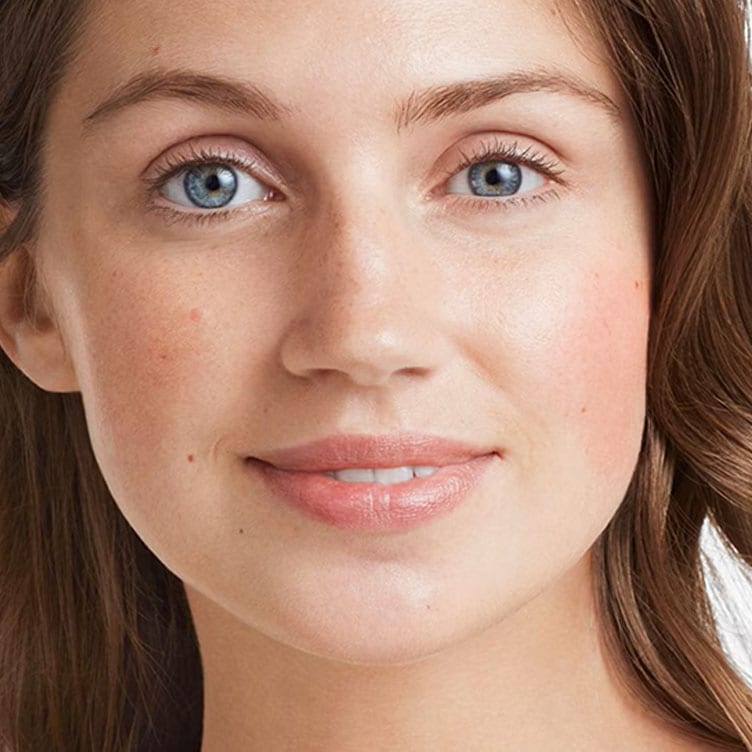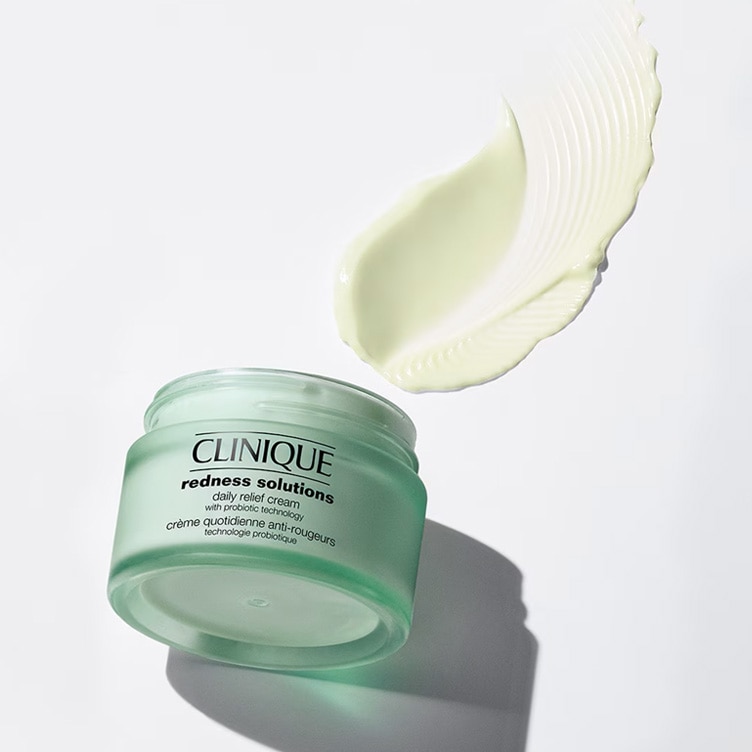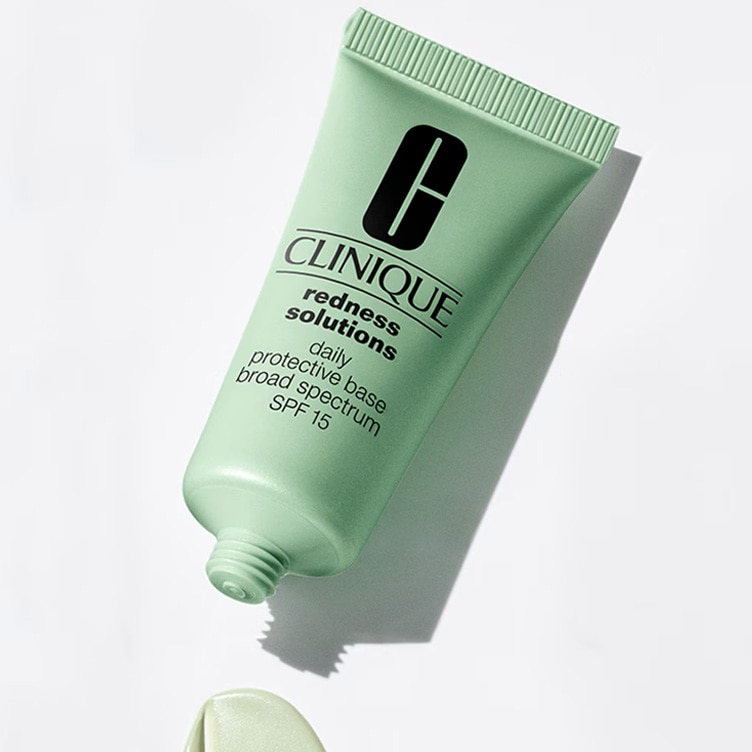
How to reduce redness on your face with skincare.
How to reduce redness on your face with skincare.
Do you find yourself blushing or flushing more easily than other people? What may initially appear as a natural rosy glow can sometimes be a result of skin irritation.
Often, facial skin redness occurs with exposure to certain internal and external influences, from spicy foods and alcohol to stress, UV rays, extreme temperatures, environmental irritants and more. Another cause is rosacea, a common, long-term skin condition which presents as visible skin redness.
Keep reading to learn all about redness and rosacea and what causes it, and discover our best redness solutions and skincare for rosacea. If you're wondering how to reduce redness, your search for an effective redness-calming routine ends here.



What causes redness of the face?
According to Dr. Jenny Liu, board-certified dermatologist, many redness-causing skin conditions, including rosacea, are often a result of genetics and environmental triggers. That means that exercise, drastic temperature changes, allergens, strong chemicals and even beauty treatments like waxing can sometimes lead to temporary facial skin redness and irritation.
Certain skincare products can also cause facial skin redness, sensitivity and irritation. Some of the common culprits for skin irritation are essential oils and synthetic fragrances, which should be avoided throughout your routine. Even if you don't experience sensitivity, redness or rosacea, fragrance is unlikely to do your skin any favours, which is why we specialise in 100% fragrance-free, allergy-tested skincare. Every single formula is meticulously allergy tested to ensure there are no reactions, delivering the utmost safety and efficacy at every step in your routine.
Rosacea is a long-term skin condition, which causes facial flushing, redness, blotchiness and sensitivity, most commonly on the nose and cheeks. Many environmental factors can trigger rosacea flare-ups, including heat, UV rays, stress and diet, however rosacea triggers can be different for everyone. While there is no known cure for rosacea, rosacea treatments can help to manage the symptoms and reduce the appearance of visible redness.
Whatever is triggering your redness flare-ups, sun protection is a must, as UV rays can cause redness, burn the skin and lead to premature skin ageing. Dermatologists recommend applying a minimum of SPF 30 to your face and neck, every day. Learn more about how to apply sunscreen correctly in our SPF guide.



What can redness look like?
Persistent skin redness typically appears as a noticeably rosy tint or blotches on the cheeks, nose, chin or forehead. This redness can feel warm or even hot to the touch, sometimes accompanied by a tingling or burning sensation. It's essential to pay attention to these signs, since understanding the cause of facial redness flareups can help you take appropriate steps to manage and maintain the health and appearance of your skin.
Facial flushing is temporary facial redness, which occurs when the blood vessels become dilated and blood flow to the face increases. Rather than just blushing cheeks, facial flushing extends across the face and commonly spreads to the neck and chest. This can be caused be everything from body temperature to emotional responses like anger and embarrassment.
What's the difference between redness and rosacea?
Everyone is likely to experience redness from time to time, but if it's persistent or frequently recurring, it could potentially be rosacea, an inflammatory skin condition. Facial redness alone generally does not indicate rosacea, but if you're experiencing a combination of the following, we recommend seeking advice from your GP or a dermatologist.
Regular flushing.
If you only flush from time to time, as a result of a common trigger like an emotional response or exteme heat, it's unlikely you have rosacea. Rosacea flushing tends to occur frequently and is often accompanied by a warm or burning sensation and itchiness.
Persistent redness.
If the skin on your face is always red, with no clear cause, it could be rosacea. Persistent rosacea redness can look and feel like blushing or sunburn that won't fade, or that occurs without any notable sun damage or exposure.
Blood vessels.
Another typical characteristic of rosacea are clusters of visible blood vessels across the face, particularly apparent around the nose and cheeks.
Sensitivity.
Skin with rosacea can be very sensitive, so you may experience sensations of stinging, burning or tingling when using skincare or makeup products.
Red bumps.
Rosacea can also cause the appearance of red blemishes and pimples on the skin (learn all about blemishes here). As acne can also present with redness, tenderness and sensitivity, it can be tricky to differentiate between the two, however rosacea doesn't cause blackheads like most forms of acne.
As rosacea is a chronic, inflammatory skin condition, it's not advisable to self-diagnose – your doctor or dermatologist is best placed to provide a diagnosis and treatment plan.



How to reduce redness
While facial redness and rosacea may not be entirely avoidable, they can be much more manageable with the right treatments. We have a full range of Redness Solutions skincare designed to help calm and combat the look of redness and irritation, with gentle formulas that are ideal for sensitive skin types. Here are a few of the best ingredients for treating redness:
Green tea extract.
Green tea is known for its soothing, antioxidant and anti-inflammatory properties, making it a great choice for sensitive skin and skin with rosacea.
Aloe vera.
If you've ever applied fresh aloe gel to angry sunburn, you'll know just how calming this natural ingredient can be. In skincare formulas like Moisture Surge™ 100H Auto-Replenishing Hydrator, aloe vera works to quench, cool and soothe the skin, which helps to relieve redness and tone down the look of redness.
Shea butter.
Shea butter is a soothing moisturising ingredient rich in antioxidants including vitamin A and E. It gives our Redness Solutions Daily Relief Cream its signature calming, creamy, nourishing texture. Our best moisturiser for rosacea, the Daily Relief Cream has been proven to be appropriate for skin with rosacea.
If you're looking for skincare to reduce facial redness, try our three-step Redness Solutions routine. This gentle, effective routine focuses on calming and soothing irritation and flush, strengthening your skin's moisture barrier and – crucially – protecting your skin from the sun. Every step is allergy-tested, 100% fragrance-free and safe for sensitive skin, ensuring it won't aggravate chronic redness like rosacea.
Step 1: Cleanse twice daily with an extra-gentle face wash.
Redness Solutions Soothing Cleanser With Probiotic Technology is your go-to for redness-prone, reactive or sensitive skin. It gently, effectively melts away dirt, makeup and impurities without aggravating the skin. Bonus: it's suitable for dry, oily or combination skin types.
As our best face wash for redness-prone skin, it's the first step you should take in your daily anti-redness regimen. This gentle facial wash is formulated with calming, hydrating ingredients like glycerin, squalane, lactobacillus extract and soothing cucumber extract.
For best results, use this cleanser for redness twice daily. Massage into damp skin, then rinse with tepid water and gently pat face dry. Tip: always avoid excessively hot or cold water if you experience redness, and avoid any harsh exfoliants or exfoliating cloths which can contribute to skin barrier damage. Learn more about your skin barrier here.
Step 2: Follow up with a specialised face cream for red skin. Safe for rosacea too.
Give your skin some comforting TLC while improving the appearance of redness with Redness Solutions Daily Relief Cream. This extra-gentle, oil-free face cream for red skin is filled with skin-loving ingredients, specially engineered to provide your face with comforting hydration that's so important for irritation and redness-prone skin.
It's also proven to be safe for rosacea skin. Our best moisturiser for rosacea, it's formulated with hydrating glycerin, soothing green tea extract and anti-irritant microbiome technology to help calm the skin and support skin's natural microbiome.
To apply our best moisturiser for rosacea, massage all over the face twice daily, avoiding the delicate eye area.



Step 3: Apply a protective base with built-in SPF.
Don't forget this crucial step in your redness management strategy: SPF. Whether you're looking for skincare for rosacea or an anti-redness skincare routine, sun protection is an essential step. Thanks to its neutralising sheer green tint, Redness Solutions Daily Protective Base SPF 15 acts as an oil-free makeup primer that instantly improves the appearance of facial skin redness, while also helping provide SPF protection. Simply apply in the morning after moisturising, before foundation.
Beyond skincare, our Redness Solutions range also includes two makeup options built with neutralising, colour-correcting pigments to conceal redness with a naturally pretty finish and medium coverage. The Redness Solutions Makeup SPF 15 is a soothing oil-free foundation for redness, formulated with lactobacillus extract and other redness-calming ingredients, while Redness Solutions Instant Relief Mineral Pressed Powder is a finely-milled mineral face powder with lactobacillus extract that's ideal for anyone with sensitive, redness-prone skin.
Our dermatologist-trained experts, at your service.
Educated in partnership with our guiding dermatologists, our in-house experts are here to help you achieve your skin goals. Equipped with diagnostic tools and education backed by dermatological science, our Clinical Consultants will help you create a bespoke skincare routine to deliver instant wins and results over time. The team’s expertise, combined with our advanced dermatologist-developed formulas, will help you unlock your best-looking skin yet. Book your Clinical Consultation today to get started.
Commonly asked questions: FAQ
What causes redness on the face?
There are many reasons for both temporary and persistent facial redness, including skin sensitivity, allergies, irritation from harsh skincare products, sun damage, rosacea, allergies and increased blood flow caused by temperature, emotions or exercise. Most of us will experience temporary flushing in response to factors like heat, exercise and sunburn, but if you're noticing persistent periods of redness, there could be something else at play. Once you've identified the trigger, or triggers, you can work out the best course of action to manage redness effectively.
What helps with redness on the face quickly?
There's no single quick-fix to reduce facial redness, but there are a few tricks that can help calm the skin and reduce discomfort. If your skin feels hot or itchy, and looks particularly angry, we suggest applying a cool compress or soothing, gentle moisturiser to the affected area – keeping your moisturiser in the fridge is an easy way to enhance its soothing properties. For an instant fix visually, apply a colour-correcting facial base, like Redness Solutions Daily Protective Base SPF 15 followed by foundation with neutralising pigments.
What reduces redness from spots?
The redness associated with spots and blemishes requires a slightly different approach to persistent redness and rosacea. We recommend applying a targeted spot treatment with salicylic acid to help reduce inflammation and prevent future breakouts. The Clinique Redness Solutions range is suitable for all skin types, so if you do have reactive, sensitive skin that's prone to blemishes, this soothing, calming range will be perfect for you too.
What cancels redness on the face?
To visibly neutralise redness on the face, we recommend using a green-tinted colour corrector, moisturiser or primer, which helps to calm and correct red tones. Clinique's Redness Solutions also help to soothe and reduce visible redness, while calming the skin over time. Always stick to gentle, fragrance-free formulas to avoid irritation.
Shop skincare for redness: